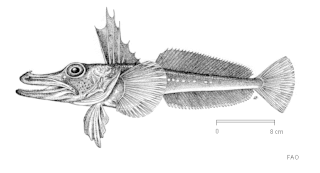
The boreal owl or Tengmalm's owl is a small owl. It is known as "boreal owl" in North America, and in Europe typically as "Tengmalm's owl" after Swedish naturalist Peter Gustaf Tengmalm or, more rarely, "Richardson's owl" after Sir John Richardson. The scientific name is from Latin. The genus name Aegolius is a type of screech owl thought to be a bird of ill omen, and funereus means "funereal".

Protosuchus is an extinct genus of carnivorous crocodylomorph from the Early Jurassic. The name Protosuchus means "first crocodile", and is among the earliest animals that resemble crocodilians. Protosuchus was about 1 metre (3.3 ft) in length and about 40 kilograms (88 lb) in weight.

The water vole is the largest North American vole. It is found in the northwestern United States and southern parts of western Canada. This animal has been historically considered a member of genus Arvicola, but molecular evidence demonstrates that it is more closely related to North American Microtus species. Water voles are on the USDA Forest Service Region 2 sensitive species list because they maintain very small populations and there is high concern that their required habitat may be declining.

The Richardson's collared lemming is a small North American lemming. At one time, they were considered to be a subspecies of the Arctic lemming, Dicrostonyx torquatus. Some sources believe they are a subspecies of the northern collared lemming, Dicrostonyx groenlandicus.

Pentaceros richardsoni, the pelagic armourhead, Richardson's boarfish or southern boarfish, is a species of marine ray-finned fish, an armourhead from the family Pentacerotidae. It has a wide distribution in the oceans of the southern hemisphere. It is commercially important as a food fish.

The northern olingo, also known as the bushy-tailed olingo or as simply the olingo, is a tree-dwelling member of the family Procyonidae, which also includes raccoons. It was the first species of olingo to be described, and while it is considered by some authors to be the only genuine olingo species, a recent review of the genus Bassaricyon has shown that there are a total of four olingo species, although two of the former species should now be considered as a part of this species. Its scientific name honors William More Gabb, who collected the first specimen. It is native to Central America.

The Western brook lamprey is a small (<18 cm), widely distributed, non-parasitic species of jawless fish endemic to the freshwater coastal waterways of the western United States and Canada. Its range extends from the North American Pacific coast from Taku River, southern Alaska, to central California, including Vancouver Island, with major inland distributions in the Columbia and Sacramento-San Joaquin watersheds.
The northern groove-toothed shrew mouse is a species of rodent in the family Muridae found in West Papua, Indonesia and Papua New Guinea.
The glacier rat is a species of rodent in the family Muridae. It is endemic to the New Guinea Highlands near Puncak Trikora and Puncak Jaya, West Papua, Indonesia. Its altitudinal range is 3,225–4,500 m (10,581–14,764 ft) above sea level.

The Saint Lucia black finch is a species of bird in the family Thraupidae. It is endemic to Saint Lucia, where its natural habitats are subtropical or tropical moist lowland forest, subtropical or tropical dry shrubland, and plantations. It is threatened by habitat loss.

The lemon-throated barbet is a species of bird in the New World barbet family Capitonidae. The species is closely related to the flame-throated barbet, and several authorities consider them the same species. These two species are the only in their genus to live in the lowlands. There are two subspecies, the nominate race, E. r. richardsoni, found in central and southern Columbia, eastern Ecuador and northern Peru, and E. r. nigriceps, found in north-east Peru and the extreme north west of Brazil.

Cimoliasaurus was a plesiosaur that lived during the Late Cretaceous (Maastrichtian) of New Jersey. It grew from 13 to 25 ft long.
Pseudochironomini is a tribe of midges in the non-biting midge family (Chironomidae).
Pseudochironomus is a genus of European and North American non-biting midges in the subfamily Chironominae of the bloodworm family Chironomidae.
The Dead Sea toothcarp is a subspecies of the Arabian toothcarp that is endemic to the Dead Sea basin, although molecular evidence suggests that it should be regarded as a species. It is threatened by water fluctuation, and the introduction of cichlids and Gambusia. The sub-specific name of this fish honours the Scottish surgeon and naturalist John Richardson (naturalist) (1787-1865) who first reported killifish in the Dead Sea basin.
The southern groove toothed moss-mouse is a species of rodent in the family Muridae found in Southern Papua New Guinea. As opposed to M. richardsoni, argenteus sp can be differentiated most prominently by its gray-brown pelage.
Isoperla richardsoni, the sterling stripetail, is a species of green-winged stonefly in the family Perlodidae. It is found in North America.
Polia richardsoni is a species of cutworm or dart moth in the family Noctuidae first described by Curtis in 1834. It is found in North America.

Sphaerodactylus richardsonii, also known commonly as Richardson's least gecko or the northern Jamaica banded sphaero, is a small species of lizard in the family Sphaerodactylidae. The species is endemic to Jamaica.

Channichthys rhinoceratus, the unicorn icefish, is a species of crocodile icefish found only around the Kerguelen-Heard Plateau in the Southern Ocean. It is a demersal species living from surface waters to depths up to 750 m (2,460 ft). It is considered by some researchers as the only species in the genus Channichthys.











